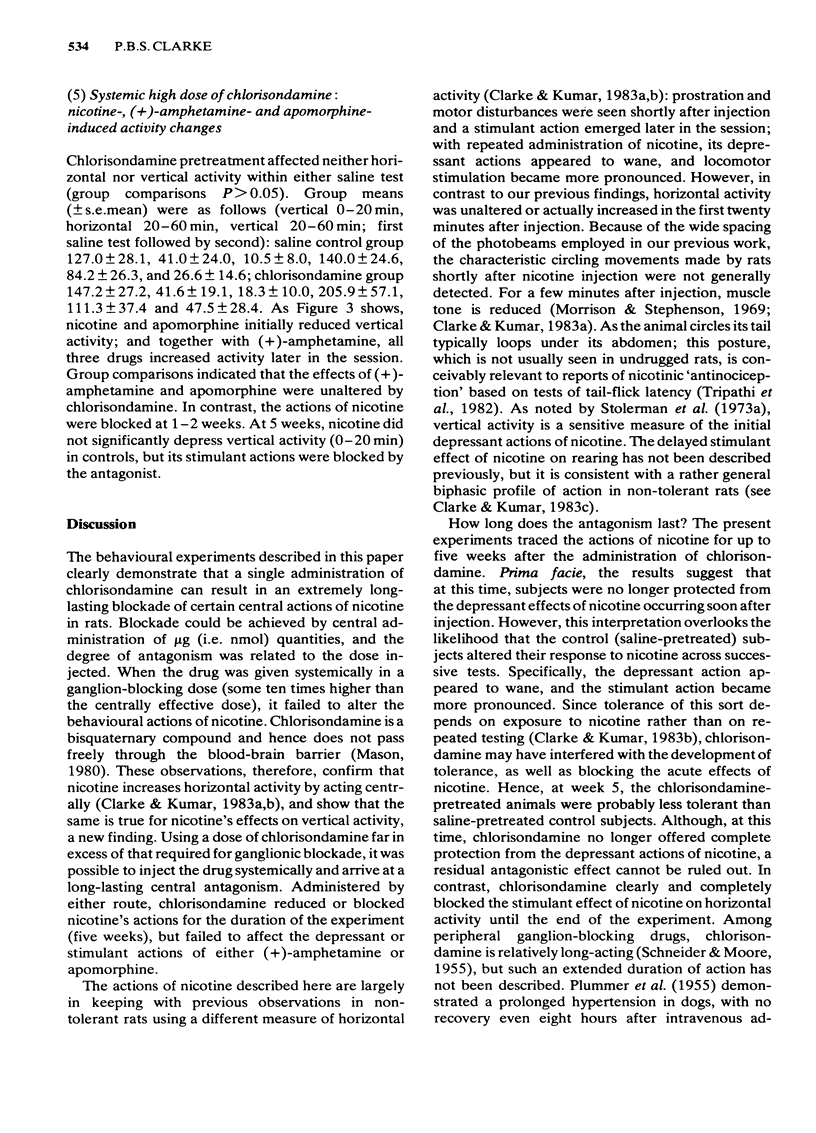Abstract
Drug-naive rats were tested for horizontal and vertical activity in photocell cages, for up to 80 min starting immediately after a subcutaneous injection of (-)-nicotine bitartrate or 0.9% w/v NaCl solution (saline). Nicotine (0.1 to 0.4 mg kg-1 base) depressed vertical activity and induced ataxia in the first 20 min, but increased both horizontal and vertical activity later in the session; these actions were dose-dependent. A single intraventricular (i.v.t.) injection of chlorisondamine Cl (2 microgram base), a quaternary ganglion-blocking drug, given one to two weeks before testing, blocked the ataxic and stimulant actions of nicotine. The antagonistic actions of chlorisondamine (0.2, 1.0, 5.0 micrograms i.v.t., single administration) were shown to be dose-dependent. The stimulant actions of nicotine were blocked in a dose-dependent way for the duration of the experiment (5 weeks); nicotine's depressant actions were completely blocked at two weeks but not at five weeks. A ganglion-blocking dose of chlorisondamine (0.1 mg kg-1), given subcutaneously (s.c.), failed to reduce the behavioural actions of nicotine, whereas a much higher systemic dose (10 mg kg-1 s.c.) was effective for at least five weeks. Chlorisondamine failed to alter the behavioural effects of (+)-amphetamine or apomorphine, while blocking those of nicotine. It is concluded that chlorisondamine antagonizes some of nicotine's central actions in a potent, long-lasting and pharmacologically selective way.
Full text
PDF








Selected References
These references are in PubMed. This may not be the complete list of references from this article.
- BLOOM F. E., COSTA E., SALMOIRAGHI G. C. ANALYSIS OF INDIVIDUAL RABBIT OLFACTORY BULB NEURON RESPONSES TO THE MICROELECTROPHORESIS OF ACETYLCHOLINE, NOREPINEPHRINE AND SEROTONIN SYNERGISTS AND ANTAGONISTS. J Pharmacol Exp Ther. 1964 Oct;146:16–23. [PubMed] [Google Scholar]
- Bryson R., Biner P. M., McNair E., Bergondy M., Abrams O. R. Effects of nicotine on two types of motor activity in rats. Psychopharmacology (Berl) 1981;73(2):168–170. doi: 10.1007/BF00429211. [DOI] [PubMed] [Google Scholar]
- Clarke P. B., Kumar R. Characterization of the locomotor stimulant action of nicotine in tolerant rats. Br J Pharmacol. 1983 Nov;80(3):587–594. doi: 10.1111/j.1476-5381.1983.tb10733.x. [DOI] [PMC free article] [PubMed] [Google Scholar]
- Clarke P. B., Kumar R. Nicotine does not improve discrimination of brain stimulation reward by rats. Psychopharmacology (Berl) 1983;79(2-3):271–277. doi: 10.1007/BF00427826. [DOI] [PubMed] [Google Scholar]
- Clarke P. B., Kumar R. Some effects of nicotine on food and water intake in undeprived rats. Br J Pharmacol. 1984 May;82(1):233–239. doi: 10.1111/j.1476-5381.1984.tb16463.x. [DOI] [PMC free article] [PubMed] [Google Scholar]
- Clarke P. B., Kumar R. The effects of nicotine on locomotor activity in non-tolerant and tolerant rats. Br J Pharmacol. 1983 Feb;78(2):329–337. doi: 10.1111/j.1476-5381.1983.tb09398.x. [DOI] [PMC free article] [PubMed] [Google Scholar]
- Morrison C. F., Goodyear J. M., Sellers C. M. Antagonism by antimuscarinic and ganglion-blocking drugs of some of the behavioural effects of nicotine. Psychopharmacologia. 1969;15(5):341–350. doi: 10.1007/BF00403709. [DOI] [PubMed] [Google Scholar]
- PLUMMER A. J., TRAPOLD J. H., SCHNEIDER J. A., MAXWELL R. A., EARL A. E. Ganglionic blockade by a new bisquaternary series, including chlorisondamine dimethochloride. J Pharmacol Exp Ther. 1955 Oct;115(2):172–184. [PubMed] [Google Scholar]
- Romano C., Goldstein A. Stereospecific nicotine receptors on rat brain membranes. Science. 1980 Nov 7;210(4470):647–650. doi: 10.1126/science.7433991. [DOI] [PubMed] [Google Scholar]
- SCHNEIDER J. A., MOORE R. F., Jr Electrophysiological investigation of chlorisondamine dimethochloride (Ecolid T.M.) a new ganglionic blocking agent. Proc Soc Exp Biol Med. 1955 Jul;89(3):450–453. doi: 10.3181/00379727-89-21841. [DOI] [PubMed] [Google Scholar]
- STONE C. A., MECKELNBURG K. L., TORCHIANA M. L. Antagonism of nicotine-induced convulsions by ganglionic blocking agents. Arch Int Pharmacodyn Ther. 1958 Nov-Dec;117(3-4):419–434. [PubMed] [Google Scholar]
- Schwartz R. D., McGee R., Jr, Kellar K. J. Nicotinic cholinergic receptors labeled by [3H]acetylcholine in rat brain. Mol Pharmacol. 1982 Jul;22(1):56–62. [PubMed] [Google Scholar]
- Sethi O. P., Gulati O. D. Analysis of mode of action of some nicotinic blocking drugs. Jpn J Pharmacol. 1973 Aug;23(4):437–451. doi: 10.1254/jjp.23.437. [DOI] [PubMed] [Google Scholar]
- Stolerman I. P., Fink R., Jarvik M. E. Acute and chronic tolerance to nicotine measured by activity in rats. Psychopharmacologia. 1973 Jun 29;30(4):329–342. doi: 10.1007/BF00429192. [DOI] [PubMed] [Google Scholar]
- Stolerman I. P., Goldfarb T., Fink R., Jarvik M. E. Influencing cigarette smoking with nicotine antagonists. Psychopharmacologia. 1973;28(3):247–259. doi: 10.1007/BF00429305. [DOI] [PubMed] [Google Scholar]
- Stolerman I. P., Pratt J. A., Garcha H. S., Giardini V., Kumar R. Nicotine cue in rats analysed with drugs acting on cholinergic and 5-hydroxytryptamine mechanisms. Neuropharmacology. 1983 Sep;22(9):1029–1037. doi: 10.1016/0028-3908(83)90021-7. [DOI] [PubMed] [Google Scholar]
- Tripathi H. L., Martin B. R., Aceto M. D. Nicotine-induced antinociception in rats and mice: correlation with nicotine brain levels. J Pharmacol Exp Ther. 1982 Apr;221(1):91–96. [PubMed] [Google Scholar]


